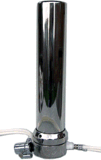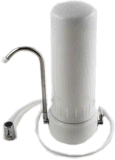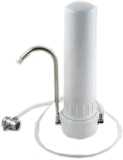| David Ozonoff, Chairman, Environmental Health Department,
Boston University:" I think the problem today is that turning on
your tap is an act of faith, and I'm not sure that that act of faith is
particularly well- placed." If you drink from the tap, there are
several recent studies you should know about because they may change the
way you think about your water.
U.S. Health Officials estimate 900,000 people each year become ill,
and possibly 900 die, from waterborne disease. The General Accounting
Office estimates 66% of Safe Drinking Water Act violations arenít
reported.
U.S. Warns of Parasite In Tap Water, Washington Post, June 16, 1995.
Between 60,000 and 1.5 million Americans a year fall ill form exposure
to waterborne cryptosporidium parasites.
Cryptosporidium, is common in water
supplies and can infect people at a very low levels, says a study
in todayís New England Journal of Medicine, March 30, 1995.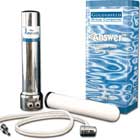
Microscopic cysts ( Giardia and/or
Cryptosporidium ) have been found in 97% of surface water supplies and
39% of drinking water supplies in the U.S.. More than 900,000
people become ill each year form waterborne parasites like Giardia and
Crypto. Waterborne illness caused by cysts can be fatal for those who
have compromised immune systems. The 50,000 Americans who are
immunocompromised have been advised to either boil all of their water or
invest in a filter that is certified by NSF International for cyst
removal.
Cryptosporidium is a round oocyst approximately 3-4 microns in
diameter, but can fold to an even smaller size. It is resistant to
chlorine disinfection, causes intestinal disorders in healthy people,
and can result in death for immunosuppressed people. Notable outbreaks
occurred in Milwaukee, WI in 1993, and Las Vegas, NV, in 1994. Giardia
is a round cyst approximately 5-6 microns in diameter. It can be killed
only by long contact with chlorine disinfection, and causes intestinal
disorders in healthy people. Recent outbreaks have occurred in
Amsterdam, NY, Oregon, Georgia, and in Golden, CO.
Microorganisms in Americas Tap Water
Over 45 million Americans drink water from treatment plants that have
found the cyst Cryptosporidium , the protozoan found in tap water that
infected over 400,000 people and killed over 100 in Milwaukee. Giardia,
a cyst that has been recognized since the 1960s, has been estimated to
cause 5 to 10 waterborne outbreaks annually, an average of 4000 hospital
admissions per year, and an average of 6 million dollars in hospital
treatment costs annually. Natural Resources Defense Council (NRDC)
attorney Erik Olson cited a report by the Centers for Disease Control
(CDC) estimating that 90,000 people a year are mad sick by such
microbial contamination of tap water.
Surface Water Treatment Rule
The Surface Water Treatment Rule states that all surface water may
potentially be used for drinking water must be filtered. Unfortunately,
problems with Cryptosporidium , Giardia, and newer protozoa (like
Cyclospora, which is larger in size than Crypto, thus more easily
filtered) are still occurring, predominantly in ground water sources
(which do not fall under the Surface Water Treatment Rule). Also,
because Cryptosporidium is pliable, it can fold down to one micron in
size, thus slipping through most public utilities filtration systems.
The only water treatment devices that can effectively filter Crypto are
those certified for submicron filtration (less than one micron).
Many cities have systems dating from before World War II, and in some
rural areas the water systems are reminiscent of the Third World. More
and more people are wondering what to do about cyrptosporidium and other
cysts in their water supplies. Thousands of water systems don't test
their water as the law requires. When water companies do test the water
and find serious pollution problems, they often don't report them to
state officials, again, as the law requires. In addition, the GAO found
that state officials often don't report violations to the EPA.
Illness From Cyst Infection
Healthy individuals infected by these parasites experience a
cholera-like illness: watery diarrhea, headache, abdominal cramps,
nausea, vomiting, and low-grade fever. For the immuno-compromised,
however, the results of infection are often grave: the parasites can
severely damage the liver and respiratory tract, as well as the
gallbladder and pancreas. Even worse, there is a 40-50% mortality rate
for the immuncompromised who are infected with Cryptosporidium. Those at
risk include cancer patients undergoing chemotherapy, infants, the
elderly, kidney dialysis patients, recent transplant recipients, AIDS
patients, and others with suppressed immune systems.
Solutions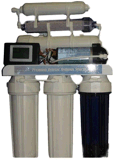
Under conditions of average temperature, humidity, and activity, the
human body loses and, therefore, must replace about 2.3 liters of water
each day. Two-thirds of this consumption is in the form of water or some
other beverage. Concerns about the health risks or taste of drinking
water may induce those who consume tap water to shift to bottled water,
or other beverages. These beverages may include sweetened soft drinks
and alcoholic beverages, which can pose health risks greater than those
associated with drinking water.
To the over 5 million Americans at risk, the CDC and the
Environmental Protection Agency have issued a guidance to either boil
all of their tap water, invest in certain bottled water, or purchase a
filter that is certified by NSF International to remove cysts. As many
can attest, boiling all of the tap water can be unduly burdensome. The
bottled water alternative also presents problems. Carol Browner, head of
the EPA, warned that bottled water is not tested for microbial
contaminants like Cryptosporidium, so consumers really donít know what
theyíre getting with bottled water.
New FDA specifications, which are nearly identical to the
Environmental Protection Agency's requirements for municipal water, are
designed to ensure that bottled water is as safe as that from the tap.
That the regulations go no further may come as a surprise to countless
consumers who have paid dearly for store-bought water. In addition, the
production and disposal of containers for alternative beverages,
including bottled water, may lead to the release of carcinogens.
It just may be the case that point-of-use filtration is the only
viable alternative to rid the nations tap water of these dangerous
contaminants. |




